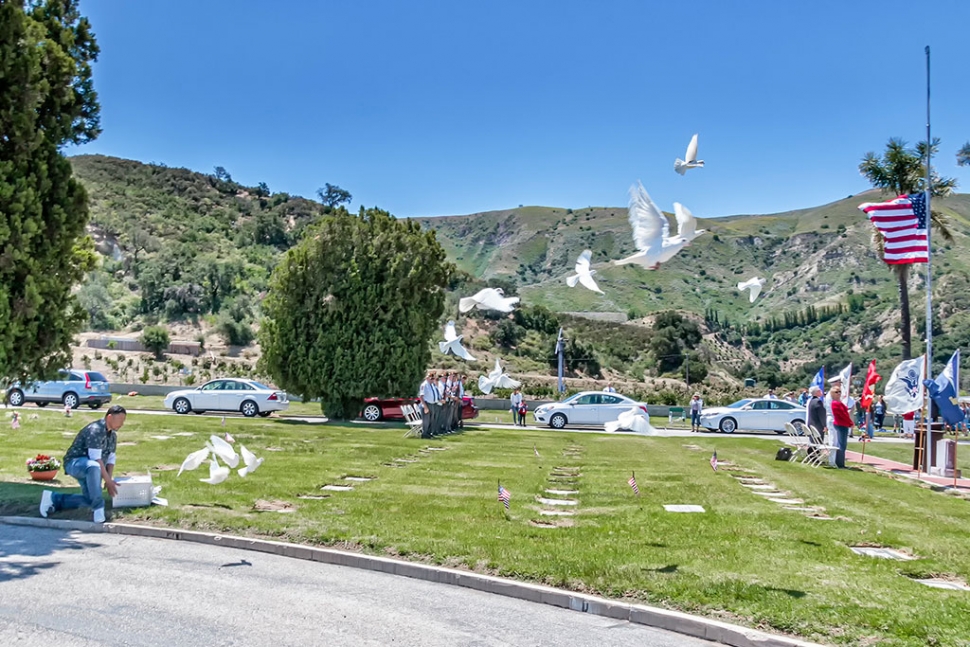|
Focus on Photography
 Photo of the Week "Released doves fly home from the Bardsdale Cemetery Memorial Day Service" by Bob Crum. Photo data: Canon 7DMKII, manual mode, Tamron 16-300mm lens @16mm. Exposure; ISO 500, aperture f/11 and 1/320 of a second. By Bob Crum — Wednesday, May 29th, 2019
Stuck feet = stagnant photos
 Bob Crum As an Air Force veteran, Memorial Day is especially relevant. While based at Kadina Air Base, Okinawa, Japan, I experienced the loss of two crew members who were also dear friends. The term “ultimate sacrifice” didn't mean much until I experienced it firsthand. I welcome the assignment to photograph the Bardsdale Cemetery Memorial Day ceremony and also to honor the fallen military service men and women who, in defense of our country, paid with the ultimate price--their lives. This assignment is perfect for describing the advantages of an all-in-one zoom lens spanning an ultra-wide spectrum of focal lengths. The Tamron 16-300mm lens is a supremely versatile photographic tool. Frequent readers know that I use it because 1) as a photojournalist, I seldom have time to change lenses and 2) Not having to change lenses helps keep my camera's sensor clean. Every time a lens is removed from an interchangeable lens camera, dSLR or mirrorless, dust can enter. It will show up in photos! Photographing the Bardsdale Memorial Day ceremony is not particularly difficult. But it's not an airshow featuring fast-flying jet planes, or Indy-race cars, or even mermaids sunbathing, so creating interesting photos is challenging. Review the photos, newsprint and online, and you'll notice I move a lot. Always moving changes the perspectives. Stuck feet = stagnant photos (remember that the next time you go to London, Paris or Rome). I then only need to concentrate on the photo composition. Photo composition is one of those mysterious intangibles. I can teach the craft of photography, but creativity, well, that's a subject for another day. Two parts of the ceremony are challenges. One is the rifle volley. It consists of the honor guard firing blank cartridges three times. Even in burst mode, I have yet to capture a muzzle flash. The challenge is exacerbated because the honor guards use low-volume powder cartridges. Best I can do is get discharged cartridges flying in the air after being fired. Still not an easy photo capture. The other is the beautiful white doves. They fly FAST! I put the camera in a slow-burst mode, which is about one frame per second. In fast burst mode, the camera would fire about seven frames per second. But the images are a tad slow going from the camera computer to the SD memory card. Which means it begins to buffer after about three seconds. Anyway, this year I was in position, the dove box in front of me, the birds flying from left to right. As the handler released the birds, I began shooting. Well, wouldn't you know that some of the doves didn't get the memo? "When the box door opens, take off and fly away." The handler opened the box door, and only half flew out. Now I'm confused. Do I photograph the ones flying away or wait, and maybe the others will catch up and make a great flock? I didn't wait. I began firing. The photo of the week is the second frame of a six-series burst. Then I started tracking the second bunch leaving the box. Remember, these magnificent birds fly really fast. No problem. Wrong! Following them was a problem. Remember the discussion about blur? Pan (track) with the subject to blur the background. At the Memorial Day ceremony, blurring the background meant blurry people!!! Wrong procedure in the wrong place. Anyway, I caught my mistake just in time to capture one photo with doves without blurring the ceremony participants. Next year!!! Send comments, suggestions or questions to: focusonphotography@earthlink.net |
